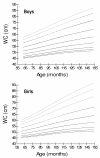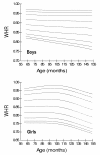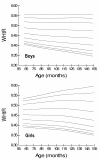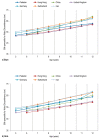Waist circumference, waist-hip ratio and waist-height ratio percentiles and central obesity among Pakistani children aged five to twelve years
- PMID: 22104025
- PMCID: PMC3239239
- DOI: 10.1186/1471-2431-11-105
Waist circumference, waist-hip ratio and waist-height ratio percentiles and central obesity among Pakistani children aged five to twelve years
Abstract
Background: Central obesity has been associated with the risk of cardiovascular and metabolic disease in children and anthropometric indices predictive of central obesity include waist circumference (WC), waist-hip ratio (WHR) and waist-height ratio (WHtR). South Asian children have higher body fat distribution in the trunk region but the literature regarding WC and related indices is scarce in this region. The study was aimed to provide age- and gender-specific WC, WHR and WHtR smoothed percentiles, and to explore prevalence and correlates of central obesity, among Pakistani children aged five to twelve years.
Methods: A population-based cross-sectional study was conducted with a representative multistage random cluster sample of 1860 primary school children aged five to twelve years in Lahore, Pakistan. Smoothed percentile curves were constructed for WC, WHR and WHtR by the LMS method. Central obesity was defined as having both age- and gender-specific WC percentile ≥90th and WHtR ≥0.5. Chi-square test was used as the test of trend. Multivariate logistic regression was used to quantify the independent predictors of central obesity and adjusted odds ratios (aOR) with 95% CI were obtained. Linear regression was used to explore the independent determinants of WC and WHtR. Statistical significance was considered at P < 0.05.
Results: First ever age- and gender-specific smoothed WC, WHR and WHtR reference curves for Pakistani children aged five to twelve years are presented. WC increased with age among both boys and girls. Fiftieth WC percentile curves for Pakistani children were higher as compared to those for Hong Kong and British children, and were lower as compared to those for Iranian, German and Swiss children. WHR showed a plateau pattern among boys while plateau among girls until nine years of age and decreased afterwards. WHtR was age-independent among both boys and girls, and WHtR cut-off of ≥0.5 for defining central obesity corresponded to 85th WHtR percentile irrespective of age and gender. Twelve percent children (95% CI 10.1-13.0) had a WC ≥90th percentile and 16.5% children (95% CI 14.7-18.1) had a WHtR ≥0.5 while 11% children (95% CI 8.9-11.6) had both WC ≥90th percentile and WHtR ≥0.5. Significant predictors of central obesity included higher grade, urban area with high socioeconomic status (SES), high-income neighborhood and higher parental education. Children studying in higher grade (aOR 5.11, 95% CI 1.76-14.85) and those living in urban area with high SES (aOR 82.34, 95% CI 15.76-430.31) showed a significant independent association. Urban area with high SES and higher parental education showed a significant independent association with higher WC and higher WHtR while higher grade showed a significant independent association with higher WC.
Conclusions: Comprehensive worldwide reference values are needed to define central obesity and the present study is the first one to report anthropometric indices predictive of central obesity for Pakistani school-aged children. Eleven percent children were centrally obese and strong predictors included higher grade, urban area with high SES and higher parental education. These findings support the need for developing a National strategy for childhood obesity and implementing targeted interventions, prioritizing the higher social class and involving communities.
Figures




Similar articles
-
Waist circumference, waist-to-hip ratio and waist-to-height ratio reference percentiles for abdominal obesity among Greek adolescents.BMC Pediatr. 2015 May 4;15:50. doi: 10.1186/s12887-015-0366-z. BMC Pediatr. 2015. PMID: 25935716 Free PMC article.
-
Central obesity in Yemeni children: A population based cross-sectional study.World J Cardiol. 2013 Aug 26;5(8):295-304. doi: 10.4330/wjc.v5.i8.295. World J Cardiol. 2013. PMID: 24009819 Free PMC article.
-
Developing waist circumference, waist-to-height ratio percentile curves for Pakistani children and adolescents aged 2-18 years using Lambda-Mu-Sigma (LMS) method.J Pediatr Endocrinol Metab. 2020 Jul 6:/j/jpem.ahead-of-print/jpem-2019-0527/jpem-2019-0527.xml. doi: 10.1515/jpem-2019-0527. Online ahead of print. J Pediatr Endocrinol Metab. 2020. PMID: 32623376
-
Diagnostic accuracy of anthropometric indices for discriminating elevated blood pressure in pediatric population: a systematic review and a meta-analysis.BMC Pediatr. 2022 Jan 4;22(1):19. doi: 10.1186/s12887-021-03062-8. BMC Pediatr. 2022. PMID: 34983442 Free PMC article.
-
The association between body mass index, waist circumference and waist-to-hip-ratio with all-cause mortality in older adults: A systematic review.Clin Nutr ESPEN. 2025 Jun;67:493-509. doi: 10.1016/j.clnesp.2025.03.051. Epub 2025 Mar 28. Clin Nutr ESPEN. 2025. PMID: 40158689
Cited by
-
Using LMS tables to determine waist circumference and waist-to-height ratios in Colombian children and adolescents: the FUPRECOL study.BMC Pediatr. 2017 Jul 11;17(1):162. doi: 10.1186/s12887-017-0919-4. BMC Pediatr. 2017. PMID: 28697745 Free PMC article.
-
Waist Circumference Percentiles and Cut-Off Values for Obesity in a Large Sample of Students from 6 To 10 Years Old Of The São Paulo State, Brazil.Arq Bras Cardiol. 2020 May-Jun;114(3):530-537. doi: 10.36660/abc.20190043. Arq Bras Cardiol. 2020. PMID: 32267326 Free PMC article. English, Portuguese.
-
[Anthropometric indices among schoolchildren from a municipality in Southern Brazil: a descriptive analysis using the LMS method].Rev Paul Pediatr. 2014 Dec;32(4):333-41. doi: 10.1016/j.rpped.2014.04.002. Rev Paul Pediatr. 2014. PMID: 25510997 Free PMC article.
-
Waist-to-hip ratio, dyslipidemia, glycemic levels, blood pressure and depressive symptoms among diabetic and non-diabetic Chinese women: a cross-sectional study.PLoS One. 2014 Oct 14;9(10):e109765. doi: 10.1371/journal.pone.0109765. eCollection 2014. PLoS One. 2014. PMID: 25314156 Free PMC article.
-
Waist circumference percentiles among Turkish children under the age of 6 years.Eur J Pediatr. 2013 Jan;172(1):59-69. doi: 10.1007/s00431-012-1822-5. Epub 2012 Sep 27. Eur J Pediatr. 2013. PMID: 23015041 Free PMC article.
References
-
- Kahn HS, Valdez R. Metabolic risks identified by the combination of enlarged waist and elevated triacylglycerol concentration. Am J Clin Nutr. 2003;78:928–934. - PubMed
Publication types
MeSH terms
LinkOut - more resources
Full Text Sources
Medical

